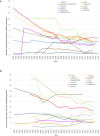Changes in the provision of psychiatric beds and incarceration in the Eastern Mediterranean Region from 1990 to 2022
- PMID: 40740266
- PMCID: PMC12307341
- DOI: 10.3389/fpsyt.2025.1539662
Changes in the provision of psychiatric beds and incarceration in the Eastern Mediterranean Region from 1990 to 2022
Abstract
Background: Psychiatric bed numbers (general, forensic, and residential) and prison populations are considered indicators of institutionalization. The present study aimed to assess trends in institutional mental health care and incarceration, measured through psychiatric bed availability and prison population rates, across the Eastern Mediterranean Region (EMR) from 1990 to 2022.
Methods: We obtained retrospective data on psychiatric bed numbers and prison populations from 22 countries between 1990 and 2022. Prevalence per 100,000 population, the median prevalence and percentage changes between the first and last data points were calculated.
Findings: Primary data were retrieved from 10 out of 22 countries. Data from secondary sources were used for the remaining 12 countries. In Libya and Somalia, primary data were only available for the prison populations. The median prevalence of psychiatric beds decreased from 8.8 to 5.8 per 100,000 population (-35%) between 1990 and 2022. An increase from 0.2 to 0.4 in forensic psychiatric beds was observed. The prevalence of beds in residential facilities was available from seven countries, two of which did not have beds between 1990 and 2022. The median rates increased from 0.1 to 0.2 between 1990 and 2022. The median prison population also increased from 86.9 to 108.0 per 100,000 people (+24%).
Interpretation: EMR countries showed, on average, a reduction in the prevalence of psychiatric beds from low numbers, while more people were imprisoned over the past three decades. The availability of forensic psychiatric beds and residential facilities has remained limited. These findings suggest a gradual shift in the EMR from institutional psychiatric care toward increased reliance on incarceration, paralleling trends observed in other global regions like Latin America and Central Eastern Europe and Central Asia.
Keywords: forensic psychiatric care; incarceration; institutionalization; prison population rate; psychiatric beds; residential care.
Copyright © 2025 Mundt, Paiman, Dalky, El-Khoury, Ghuloum, Mohammed, Delhey-Langerfeldt, Fekih-Romdhane, Elsabbahy, Marie, Saleh, Priebe and Rozas-Serri.
Conflict of interest statement
The authors declare that the research was conducted in the absence of any commercial or financial relationships that could be construed as a potential conflict of interest. The author(s) declared that they were an editorial board member of Frontiers, at the time of submission. This had no impact on the peer review process and the final decision.
Figures





References
-
- World Health Organization . WHO’s Eastern Mediterranean Region countries . Available online at: https://www.emro.who.int/countries.html (Accessed March 15, 2023).
-
- Mundt AP, Rozas Serri E, Siebenförcher M, Alikaj V, Ismayilov F, Razvodovsky YE, et al. Changes in national rates of psychiatric beds and incarceration in Central Eastern Europe and Central Asia from 1990-2019: A retrospective database analysis. Lancet Reg Health Eur. (2021) 7:100137. doi: 10.1016/j.lanepe.2021.100137, PMID: - DOI - PMC - PubMed
-
- Global Burden of Disease 2015 Eastern Mediterranean Region Mental Health Collaborators . The burden of mental disorders in the Eastern Mediterranean region, 1990-2015: findings from the global burden of disease 2015 study. Int J Public Health. (2018) 63:25–37. doi: 10.1007/s00038-017-1006-1, PMID: - DOI - PMC - PubMed
LinkOut - more resources
Full Text Sources
Miscellaneous

